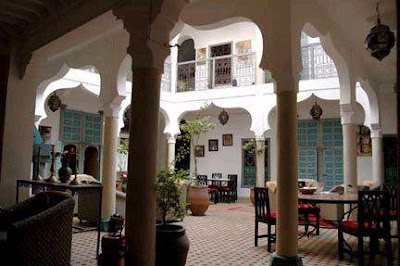 ATTICURGE
ATTICURGEA doorway having the jamb inclined inwards from the threshold to the top. A common feature of Mycenaean, Incan and Roman architecture it made its way back prominently into classical architecture as an Egyptian Revival style.
ZELLIGE
The particularly Moroccan tradition of geometric tile mosaic. Each of the myriad terra cotta pieces are cut by hand, glazed and fired. Layouts are made according to sacred geometric principles, in tri-, quatre- and cinque-fold arrangements.
Typical of zellige geometric layout is an infinite web that could extend infinitely beyond the border. This is a visible symbol of the infinite, uncentralized, nature of the universe, a implication of deep, underlying spiritual order without iconography.
 BUTTRESS
BUTTRESSWith the introduction of radial arches, vaults and domes came the structural necessity for buttresses, attached supportive masses built along the lines of introduced lateral thrust through which the load is transferred to the ground.
ONION DOME
A dome of ogee profile in section that turns back upon itself on the bottom, thus giving a bulbous character to the dome which terminates at a point. Ubiquitously associated with the Russian Orthodox church such domes can also be found in Mughal and Islamic architecture.
 TRUSS
TRUSSThe more or less triangular arrangement of support for a gabled roof, traditionally a combination of timber members form the rigid framework.
RIAD
An Arabic word for "garden", the Riad has come to describe an urban villa prominently featuring an interior, open courtyard with a pool or fountain and often mosaic floors. This Domus Italica tradition was established in North Africa during the days of Imperial Rome.
The inward facing design features thick adobe walls with little to no outside windows. Private rooms open off of colonnaded galleries with communal spaces in the courtyard below and a rooftop terrace above. The design is ideal for hot, dry climates providing privacy, security and comfort.
 MULLION, TRANSOM, MUNTIN
MULLION, TRANSOM, MUNTINPrimarily applied to windows but also terminology applicable to doors and portals. The MULLION forms the primary vertical divisions and support for the opening whereas the TRANSOM provides the secondary horizontal structural support and is also a term used for the bar separating a door below from a window above.
The MUNTINS are smaller members that secure the individual lights or panes of glass and may have any orientation.
"Rycharde Dale carpeder made thies windovs by the grac of God"
Awesome quote!!
SENSUS COMMUNIS
A shared community of taste. A subjective yet universal judgement of what ought to be considered beautiful or sublime. Not an aesthetic that can be legislated or fully determined by reason it occurs naturally in a society where experience and feeling are valued and cultivated.
Contributed by Patrick Webb





No comments:
Post a Comment